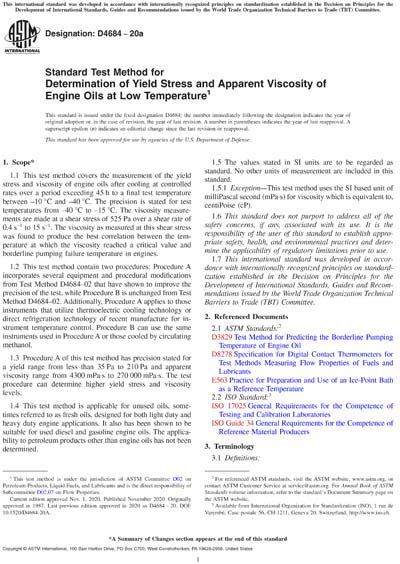Most recent
ASTM D4684-20a
Standard Test Method for Determination of Yield Stress and Apparent Viscosity of Engine Oils at Low Temperature
1.1 This test method covers the measurement of the yield stress and viscosity of engine oils after cooling at controlled rates over a period exceeding 45 h to a final test temperature between –10 °C and –40 °C. The precision is stated for test temperatures from –40 °C to –15 °C. The viscosity measurements are made at a shear stress of 525 Pa over a shear rate of 0.4 s–1 to 15 s–1. The viscosity as measured at this shear stress was found to produce the best correlation between the temperature at which the viscosity reached a critical value and borderline pumping failure temperature in engines.
1.2 This test method contain two procedures: Procedure A incorporates several equipment and procedural modifications from Test Method D4684–02 that have shown to improve the precision of the test, while Procedure B is unchanged from Test Method D4684–02. Additionally, Procedure A applies to those instruments that utilize thermoelectric cooling technology or direct refrigeration technology of recent manufacture for instrument temperature control. Procedure B can use the same instruments used in Procedure A or those cooled by circulating methanol.
1.3 Procedure A of this test method has precision stated for a yield range from less than 35 Pa to 210 Pa and apparent viscosity range from 4300 mPa·s to 270 000 mPa·s. The test procedure can determine higher yield stress and viscosity levels.
1.4 This test method is applicable for unused oils, sometimes referred to as fresh oils, designed for both light duty and heavy duty engine applications. It also has been shown to be suitable for used diesel and gasoline engine oils. The applicability to petroleum products other than engine oils has not been determined.
1.5 The values stated in SI units are to be regarded as standard. No other units of measurement are included in this standard.
1.5.1 Exception—This test method uses the SI based unit of milliPascal second (mPa·s) for viscosity which is equivalent to, centiPoise (cP).
1.6 This standard does not purport to address all of the safety concerns, if any, associated with its use. It is the responsibility of the user of this standard to establish appropriate safety, health, and environmental practices and determine the applicability of regulatory limitations prior to use.
1.7 This international standard was developed in accordance with internationally recognized principles on standardization established in the Decision on Principles for the Development of International Standards, Guides and Recommendations issued by the World Trade Organization Technical Barriers to Trade (TBT) Committee.
Content Provider
ASTM International [astm]






